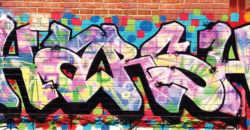Summer 2016
Top Mob
Ogden Museum showcases the history of New Orleans graffiti
Published: June 1, 2016
Last Updated: September 17, 2018
In the mid-1960s, neighborhood gangs in Philadelphia began to use graffiti to mark their territory, writing threatening messages to their rivals on the sides of buildings with paint and markers. Soon the “tags” of lone graffiti writers began to mimic this style, but with one difference—these solo artists started tagging subway and bus systems to reach a much broader audience. Their simple, linear, text-based graffiti style spread to the subway systems of New York City, where a new style was born in the transit systems. By the early 1970s, the walls of subway stations and the exteriors of trains were covered in brightly colored, highly stylized graffiti. Bolstered by the rise of hip-hop culture, a movement was born. On January 31, 1981, the music video for Blondie’s Rapture debuted on the nationally syndicated Solid Gold television program, giving audiences around the world their first glimpses of contemporary graffiti through the artwork of Jean-Michel Basquiat, Fab 5 Freddy, and George Lee Quiñones.
In New Orleans, a group of friends—using the aliases Bugs One, SGP, and Dusky—began writing graffiti together in 1984, forming a crew called Top Mob. SGP brought photographs of New York graffiti back to New Orleans, and another friend, Risk, returned with West Coast styles from Los Angeles. The Top Mob artists assimilated these writing styles into their work. The city’s growing punk and hip-hop scene expanded the roster of Top Mob artists to include names like Baser, Rock, Elle One, Kane, Kash, Axe, Harsh, and local legend DJ REAL. Bugs and SGP eventually moved to Los Angeles in the early 90’s; Bugs returned home to become an influential graffiti artist, blending East and West into a distinctly New Orleans Southern style. Over the course of 30-plus years, Top Mob has remained a relevant crew with a longevity unparalleled in the history of New Orleans graffiti.
Several of the artists in Top Mob have moved their practice from the renegade spaces of the streets into more traditional or commercial venues. Lionel Milton (Elle One) has become a celebrated artist whose commissions include clients ranging from the New Orleans Jazz & Heritage Festival and Voodoo Fest to Heineken and MTV. Another member, Dr. Daks is a brand ambassador for Pabst Blue Ribbon. Jamar Pierre (Kane) is a gallery artist and works as an educator with inner city youth. Kelly Graval (Risk) is an internationally respected graffiti artist, known as one of the first of the genre to transition successfully from the streets to gallery walls. Other members work in the film industry, arts education and graphic, fashion and jewelry design.
Though it commands significant attention in the contemporary art world, graffiti remains an art form wrought with conflict and controversy, particularly in New Orleans. Banksy brought international attention to New Orleans through a series of works executed during a visit in 2008. Swoon filled the Great Hall of New Orleans Museum of Art with her piece, Thalassa, in 2011. In 2014, ExhibitBe, a massive collaborative graffiti exhibition including work by Meek One of Top Mob, became a cultural phenomenon. The Ogden Museum of Southern Art invited the artist known as Fat Kids From Outer Space to create a site-specific aerosol mural on an interior wall in 2015 as part of the exhibition, Tina Freeman: Artists Spaces.
The Ogden Museum of Southern Art continued to explore the genre of graffiti art with Top Mob: A History of New Orleans Graffiti, on display June 4-November 6, 2016. Co-curated by Gabriel Alexander and Nicole Hershey, it included an interior exhibition tracing the development of the Southern style and its influences from 1984-2016. There was a retrospective timeline of work by Top Mob artists and other important local contributors. It also included an exterior mural stretching for 125 feet. According to the curators, “this exhibition is a visual and historical retelling of the evolution of New Orleans graffiti by the ones who were there when it started, and those who have kept it alive.”

